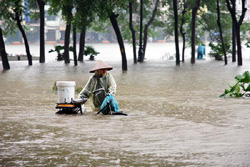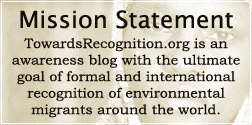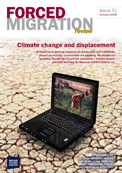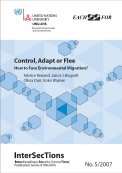
Photo credit: IRIN
(IRIN) September 9, 2009 – Many recent studies have put the number of climate-change-related migrants at between 200 million and one billion by 2050, but critics say given insufficient data it is impossible to estimate the number. Some say inflated figures have spurred “fear-of-migration” rhetoric from policymakers and leaders.
“It seems unlikely the alarmist predictions of hundreds of millions of environmental refugees moving as a result of climate change,” says Cecilia Tacoli, senior researcher with London-based NGO the Institute of Environment and Eco-Development. Tacoli will publish a study ‘Crisis or adaptation? Migration and climate change in a context of high mobility’ in October.
“What is more likely is that we will see current high mobility trends continue and intensify, linked to income diversification.”
Projected migrant figures are based on estimates of the number of people living in areas most likely to be affected by climate change, rather than the number of people who are most likely to move, Tacoli says.
A study released 4 September by the UK government’s Governance and Social Development Resource Centre (GSDRC), notes: “Climate change is an extremely complicated and complex process. Migration is equally a study in its own right. Drawing any direct causal relationships is not only methodologically wrong, it is dangerous.”
One danger of inflating migrant figures, Tacoli says, is that it foments “fear” rhetoric among national leaders, many of whom now frame climate change as a national security issue.
Rhetoric of fear
An August report by the US Department of Defense said climate-induced crises and related mass people movements could topple governments, feed terrorist movements or destabilize entire regions.
The UK Ministry of Defence’s Development, Concepts and Doctrine Centre (DCDC) states in a global trends 2007-2036 scenario: “Food and water insecurity will drive mass migration from some worst-affected areas and the effects may be felt in more affluent regions through distribution problems, specialized agriculture and aggressive food-pricing.”
And the European Union High Representative for Foreign and Security Policy, Javier Solana warned in 2008 that climate-change-related migration “may increase conflict in transit and destination areas. Europe must expect substantially increased migratory pressure.”
Reality
Crisis-led population movements are more complex and less predictable than the methodology in these estimations reflects say the reports by Tacoli and the GSDRC, but some trends have emerged. A 2009 UK-based Refugee Studies Centre report by James Morrissey notes one-off extreme events tend to generate short-term, short-distance migrations; while longer-term environmental changes tend to generate longer-distance, more permanent migrations.
Past climate-change-related displacements have tended to remain within country borders, with long-distance international movement the least likely scenario, according to researchers. And in most cases it is the most well-off who travel the farthest, while the poorest populations are often unable to move, several researchers say.
However a number of renowned researchers and institutions still predict high climate-migrant numbers, while a debate on the legal status of “climate refugees” is emerging at international climate change talks. A policy paper by the UN University Institute for Environment and Human Security Section notes climate change is already contributing to displacement and migration and projects that in the densely populated Ganges, Mekong, and Nile River deltas, a sea level rise of 1m could affect 23.5 million people.
Way forward
To reframe the debate, rather than looking at environmental “hotspots” as potential migrant sources, it is more useful to think of “hot systems” where vulnerability is high based on several factors: a community’s social dynamics, natural resource management, demographic growth, inter-community tensions and poverty, says the GSDRC.
Given the dearth of accurate data, GSDRC recommends moving forward on a case-study basis and learning from past experience. It highlights as useful models the EU’s environmental change and forced migration scenarios and a study of migration responses to natural disasters by the Norwegian Refugee Council’s Internal Displacement Monitoring Centre and the UN Office for the Coordination of Humanitarian Affairs.
Determining more accurate patterns and routes could lead to more appropriate adaptation responses, such as building up infrastructure and basic services like sanitation, piped water, electricity, health clinics and schools in small towns in developing countries, which may turn into destination hubs, researcher Tacoli says.
“Small towns in agricultural areas are especially important to provide livelihoods to the poorest groups, who are often landless and do not have the means to migrate to larger cities.”
Source: IRIN




I’m in no position to “do the math,” but am puzzled by these apparent attempts at reassurance. While migration is one adaptation to climate change, it’s not as if there’s plenty of room for more people anywhere. Where climate change causes a rise in sea level, people must either relocate horizontally, get a houseboat or taller stilts for their houses – or drown. Where climate change reduces the locally grown supply of food, people must either move to better areas (which are already spoken for) or import food. I’ll admit I’ve seen many hectares of golf courses and estate-sized manicured lawns in the USA which could be converted to well-managed organic agriculture. But I don’t know what it would take to make these changes, or if it could be done fast enough to get ahead of climate-change emigrations. I think humanity is far too populous,and we don’t have enough wiggle room to adapt comfortably. I’m afraid there’s going to be a hard fall.